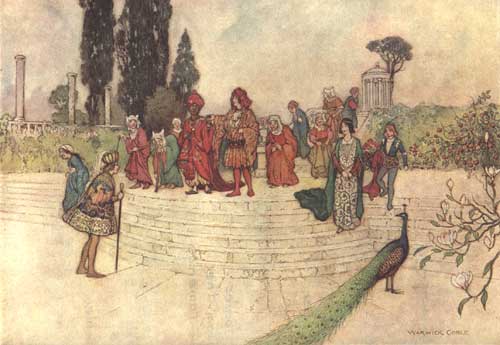
“Penta with the Maimed Hands” is an Italian tale, written by Giambattista Basile in his 1634 work, the Pentamerone. Interesting, the is not the first story I’ve read about a girl whose hands get chopped off, but this one is entirely different from the Grimms’ “The Girl Without Hands.” The Pentamerone is a collection of 50 stories, told within a frame story of a deceitful queen who has demanded that her husband tell her stories, and he in turn has hired a group of ten female storytellers who each tell five stories over five days. “Penta with Maimed Hands” is the second story of the third day.
The king of Pietrasecca lost his wife and fell in love with his sister, Penta. He implored her to marry him. When she refused and he continued to implore her, she asked what attracted him, and he praised her beauty, but most highly, her hands. She tricked a slave into cutting off her hands, and in anger the king had her put in a chest and thrown into the sea. A fisherman caught the chest in his nets and brought her home, but his wife, Nuccia, was jealous of Penta’s beauty and threw her back into the sea. The king of Terraverde saw the chest and rescued her, making her his queen’s lady-in-waiting. Shortly thereafter, the queen fell ill and asked him to marry Penta. He agreed, she died, and he married Penta. He had to go on a journey, and while he was gone, Penta gave birth to a baby. The king’s servants sent a message, but the ship was thrown by a storm on the shore where the fisherman, who had rescued Penta, and Nuccia got the captain drunk and substituted a letter that said she had given birth to a monstrous dog. The king received this message and sent back a letter that the queen should not be distressed, and they should all comfort her, but Nuccia substituted a letter ordering that the queen and her son were to be burned. The king’s councilors concluded that he had gone mad and sent Penta and her son away. She traveled to a kingdom ruled by a magician, who gave her shelter and promised a reward to whoever could tell him the most miserable tale.
The king returned home, heard all the stories, and concluded that Nuccia had caused the problems. He went to her home and had her burned.
When he heard that the cause of the whole affair was her jealousy, he designed to make her into a candle, so when she had been well smeared with wax and tallow, he had her placed on top of a great pile of dry wood which was then set alight.
He watched the burning, and when he saw that the fire had licked its scarlet tongue round the miserable woman and devoured her, he set sail.
He heard of the magician’s offer from king of Pietrasecca, who he didn’t realize was Penta’s brother, and was certain that he could win the prize. They both went, and Penta’s brother recounted his wickedness and how he had thrown his own sister into the sea. Penta’s husband recounted his tale. The magician showed them Penta and her son, and declared that her husband had suffered the most miserably, so that Penta and her husband would be his heirs. Then he tells Penta to hide her stumps under her girdle and when she pulls them out again, her hands have grown back, more beautiful than ever.
Happy endings all around.
The first king quite obviously has issues, but I like that he has a change of heart, realizes how evil he was and is remorseful. The second king is rather interesting though. He obviously truly loves Penta, but he isn’t all concerned that, at least he is told, she had a dog for a baby instead of a boy. Seems a little odd to me.
I like Penta. She’s obviously a tough lady, making her own choices and sticking by them. And I like the second king, who accepts and loves her no matter what.
The story can be read in several places. I read it on-line at The Gold Scales.
By the way,back to the evil princess in the frame story. She is originally a slave who basically stole the Prince from the woman who should have been married to him. Her treachery is revealed in the final story and she is buried, pregnant, up to her neck in the ground and left to die. The true Princess and the Prince live happily ever after. Apparently Basile was pretty good at punishing the villains, just like in a lot of fairy tales.
Thursday’s Tales is a weekly event here at Carol’s Notebook. Fairy tales, folktales, tall tales, even re-tellings, I love them all.

Having a title that filled me with sadness, I was so relieved to read that this had a happy ending.
I liked that he wasn’t bothered by her giving birth to a dog, he loved her very much 🙂 Still glad that there was no dog 😉